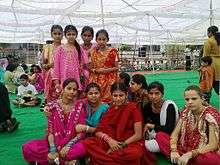Meghwal
The Meghwal (also known as Megh and Meghwar) people live primarily in northwest India, with a small population in Pakistan. Their traditional occupation was weaving. Meghwals are known for their contribution to embroidery and the textile industry. Most are Hindu by religion, with Rishi Megh, Kabir, Ram Devji and Bankar Mataji their chief gods. They were considered to be an untouchable community and are now classified as a Scheduled Caste under India's reservation system.[1][2]
 A group of Megh girls in Jammu, India | |
| Regions with significant populations | |
|---|---|
| • India • Pakistan | |
| Religion | |
| •Hinduism |
Synonyms
The Meghwal community is known by various names, depending on location. Examples include Megh and Menghvar.
Origins
They claim to have descended from Rishi Megh,[1] a saint who had the power to bring rain from the clouds through his prayer.[3] The word Meghwar is derived from the Sanskrit words megh, meaning clouds and rain, and war (Hindi: वार), meaning a group, son and child. (Sanskrit: वार:)[4][5] Literally, then, the words Meghwal and Meghwar connote a people who belong to Megh lineage.[6]
Some Meghwals are associated with other social groups. Shyam Lal Rawat refers to the Meghwals of Rajasthan as "one of the dominating low untouchable castes ... earlier known as Chamars",[7] a connection also made by Debashis Debnath.[8] The Balali and Bunkar communities have also begun using the Meghwal name.[9]
Geographical distribution
The Meghwal are found in Gujarat, Madhya Pradesh, Maharashtra and Rajasthan. The Meghs, Kabir Panthi or Bhagat are from Himachal Pradesh and Jammu and Kashmir[10] and are known as Megh, Arya Megh and Bhagat. In some places they are known as Ganeshia, Meghbansi, Mihagh, Rakhesar, Rakhia, Rikhia, Rishia and other names. Some of the Mahashas also claim to be belonging to Meghs.[11] After Partition of India in 1947, the Meghs who had become converts to the Hinduism, had to migrate to Indian territory.[12]
As of 1991, the population of Meghs in Punjab (India) was estimated at 105,157.[13]
Lifestyle
In the countryside of Rajasthan, many of the people of this community still reside in small hamlets of round, mud-brick huts painted on the outside with colourful geometric designs and decorated with detailed mirror inlays. In earlier days the main occupation of the Meghwal community was agricultural labour, weaving, specially Khadi and woodcarving, and these are still the main occupations. The women are famous for their embroidery work and are master wool and cotton weavers.[14][15]
Increasing numbers of the Meghwal today are educated and are obtaining government jobs. In Punjab, especially in the cities like Amritsar, Jalandhar and Ludhiana a good number of them is engaged as workers in factories producing sports, hosiery, surgical and metal goods. Very few of them have their own business or a small scale industry. Tiny business and service units are their main support for livelihood.[16]
Their staple diet includes rice, wheat and maize, and pulses such as moong, urad and channa. They are not vegetarian but eat egg, fish, chicken and mutton when available, although they abstain from pork, beef and buffalo meat.[3]
Women have low status in traditional Meghwal society. Marriages are arranged through negotiation between the families before puberty. After marriage, the wife moves to the husband's house, except for the period of childbirth. However, divorce is allowed, with the father retaining liability for the children and compensation paid to the wife.[3]
Arts
The Meghwal women in Rajasthan are renowned for their exuberantly detailed costumes and jewellery. Married women are often spotted wearing gold nose ring, earrings and neckpieces. They were given to the bride as a "bride wealth" dowry by her soon-to-be husband's mother. Nose rings and earrings are often decorated with precious stones of ruby, sapphire and emerald. The Meghwal women's embroidery is avidly sought after. Their work is distinguished by their primary use of red, which comes from a local pigment produced from crushed insects. The Meghwal women artisans of Thar desert in Sindh and Balochistan, and in Gujarat are considered master of the traditional embroidery and Ralli making. Exotic hand-embroidered items form part of dowry of Meghwal woman.[17]
References
| Wikimedia Commons has media related to Meghwal. |
- "Regional Briefs, Punjab, Abohar". Retrieved 24 August 2009.
- "The Kāmaḍ of Rajasthan – Priests of a Forgotten Tradition. Journal of the Royal Asiatic Society of Great Britain & Ireland (Third Series), 6 , pp 29–56". Cambridge University Press. pp. 29–56. Retrieved 5 June 2010.
- D. K. Samanta; S. K. Mandal; N. N. Vyas; Anthropological survey of India (1998). Rajasthan, Part 2, Volume 38 of "People of India". Popular Prakashan. pp. 629–632. ISBN 81-7154-769-9.
- Alok Kumar Rastogi & Shri Sharan. Supreme Sanskrit-Hindi Kosh. Kalra Publications (Pvt.) Ltd., Delhi.
- "The practical Sanskrit-English dictionary". Retrieved 9 September 2009.
- "English Hindi Dictionary: Cloud". Shabdkosh.com. Retrieved 24 August 2009.
- Rawat, Shyam Lal (2010). Studies in Social Protest. pp. xiv, 356. ISBN 978-8131603314.
- Debnath, Debashis (June 1995). "Hierarchies Within Hierarchy: Some Observations on Caste System in Rajasthan". Indian Anthropologist. 25 (1): 23–30. JSTOR 41919761.
- Dalit Women in Rajasthan: Status of Economic, Social & Cultural Rights (PDF).
- Census India - Govt. of India
- Mark Juergensmeyer. (1988). Religious Rebels in The Punjab: The Social Vision of Untouchables. Ajanta Publications, Delhi. p. 214. ISBN 81-202-0208-2.
- Mark Juergensmeyer. (1988). Religious Rebels in The Punjab: The Social Vision of Untouchables. Ajanta Publications, Delhi. p. 225. ISBN 81-202-0208-2.
- "Dalits – On the Margins of Development" (PDF). Archived from the original on 21 July 2011. Retrieved 15 August 2009.CS1 maint: unfit url (link)
- "Weaving a common destiny". Centre for Science and Environment. June 1992. Retrieved 15 August 2009.
- "Ancient Lac Dyeing Practices of Kachchh and its revival by the Vankar Shyamji Valiji of Bujodi". Craft Revival Trust. Retrieved 15 August 2009.
- "Innovations, Entrepreneurship and Development". Journal of Entrepreneurship. Retrieved 11 April 2010.
- Jasleen Dhamija; Crafts Council of India (2004). Asian embroidery. Abhinav Publications. p. 125. ISBN 81-7017-450-3.